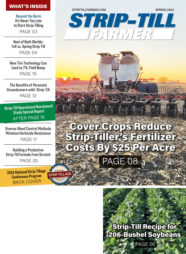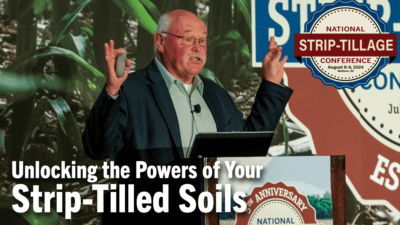When the Beckman family began adopting precision farming technology on their 4,000 acre operation near Elgin, Neb., they had the foundation in place for a smooth transition to strip-till.
Matt, who farms with his father, Dave, uncle, John, and brothers, Luke, and Josh, run predominantly John Deere equipment on their corn and soybean operation. They still utilize several tillage practices, depending on field conditions, and several fields are under center-pivot irrigation.
They use variable-rate seeding and will adjust phosphorus (P) application rates based on the yield maps they have built with Apex farm management software. All of their variable-rate fertilizer mapping is done by the local coop and is based off of grid soil sampling.
“We don’t do that with the Apex program,” Matt says. “We do some of the variable-rate seeding maps ourselves with Apex, and the coop will do some as well if we don’t have enough consistent yield data available. When we started considering our first auto-steer system, for simplicity’s sake, we decided to stay with the Deere system.”
Over the years, they have continued to adopt precision methods in their operation, switching to an RTK signal at the same time they started strip-tilling in 2012.
“We don’t have table-top flat fields, so we have added a ProTrakker implement guidance hitch to help the planters track the strip-till pass on hilly ground,” Matt says. “That took some doing, getting the implement, the hitch and the tractor guidance systems working together. Without it, the tractor would be driving on top of rows to keep the planter aligned with the strip-till pass.”
The strip-till unit is a Twin Diamond 12-row Strip Cat unit that also applies ammonia and P on corn ground, usually in an early spring pass followed by a planter pass that applies additional fertilizer in the furrow and banded over the row.
“When we’re trying to use the exact A-B line as the strip-till pass, it’s another level of accuracy,” Matt says.
Point of Pain: Be Prepared to Revisit and Revise
Beckman says the family — through trial and error — understands that it’s important to be prepared with precision equipment so they can take full advantage of its features in the busy spring and fall seasons.
They’ve learned the hard way, continuing to plant or harvest while waiting for the dealer to help solve precision equipment glitches.
“We’ve had the equipment for enough years that we are familiar with it and it works well with our equipment,” Matt says. “We seem to run into issues when there is a software upgrade and some additional work is needed to get all components working together.
“It happens over such a tight window of time, we are always making notes of things that need to be done the next time we use it. The dealer has been very helpful, but they certainly need to study ahead and be prepared for these glitches. It’s not good for us to be half or three-fourths the way through the season before the equipment is working properly.”
Matt also believes it’s time to circle back and fine tune precision planting processes and data that will produce even better precision prescriptions.
“We like the yield and lower input cost trends with strip-till and we want to be able to have even better data so we can make even better prescription maps for fertility and planting rates,” he says.






Post a comment
Report Abusive Comment